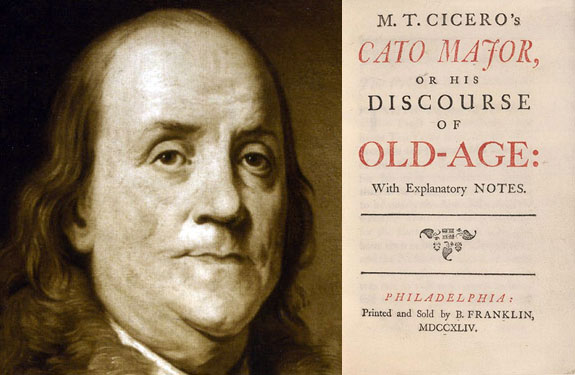February 29
“The Printer to the Reader, Philadelphia, February 29, 1743/4.” So began the colophon to M.T. Cicero’s Cato Major, or His Discourse on Old Age, printed and published by Benjamin Franklin, and considered to be Franklin’s finest effort as a printer. The colophon continued:
“This version of CICERO’S TRACT de Senectute, was made Ten Years since, by the Honourable and Learned Mr. LOGAN, of this City; undertaken partly for his own amusement, (being then in his 60th year, which is said to be nearly the Age of the Author when he wrote it) but principally for the Entertainment of a Neighbour then in his grand Climacteric; and the Notes were drawn up solely on that Neighbour’s Account, who was not so well acquainted as himself with the Roman History and Language: Some other Friends, however, (among whom I had the Honour to be ranked) obtained Copies of it in M.s. And, as I believed it to be in itself equal at least, if not far preferable to any other Translation of the same Piece Extant in our Language, besides the Advantage it has of so many valuable Notes, which at the same time they clear up the Text, are highly instructive and entertaining; I resolved to give it an Impression, being confident that the Publick would not unfavourably receive it.
“A certain Freedman of Cicero’s is reported to have said of a medicinal Well, discovered in his Time, wonderful for the Virtue of its Waters in restoring Sight to the Aged, That it was a Gift of the bountiful Gods to Men, to the end that all might have the pleasure of reading his Master’s Works. As that Well, if still in being, is at too great a Distance for our Use, I have, Gentle Reader, as thou seest, printed this Piece of Cicero’s in a large and fair Character, that those who begin to think upon the Subject of OLD-AGE, (which seldom happens till their Sight is somewhat impair’d by its Approaches) may not, in Reading, by the Pain small Letters give the Eyes, feel the Pleasure of the Mind in the least allayed.”
Franklin’s “large and fair Character” was truly just that. The introduction was set in 24-point type, and the text in 18-point, with footnotes in 12-point. Such a book represented a distinct departure from the editions of the classics then available, in which 10-point or even 8-point was not at all unusual for text composition.
Cato Major is recognized as one of the handsomest books produced in the American Colonies. Franklin’s experiences as a compositor in one of the best London printing offices gave him an insight into fine book-making which was denied to most colonial printers. As a prosperous printer he also was in a position to do a prestige item, which might not necessarily be profitable.
